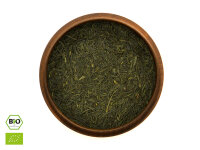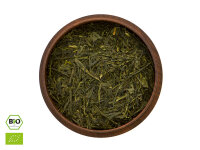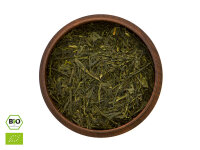
Sencha Tea
Sencha - Japan's Most Popular Green Tea
Sencha is the most popular and, at the same time, the most commonly cultivated green tea in Japan. It is brewed from young, lightly steamed leaves. Its color ranges from a pale greenish-yellow to a rich light green. Typically, this tea is not shaded, but we have also selected a shaded Sencha for our assortment.
The taste is diverse and can vary depending on the region, harvest, and cultivation area. Selected varieties of this tea often offer a lot of umami and a pleasant, mild bitterness, combined with a touch of astringency. An intense, dark green leaf is also an indicator of the tea's quality.
The quality of Sencha varies widely, depending on the variety, ranging from lower to absolute top quality. Selected Sencha can even compete well with the exclusive Gyokuro. The rapid but gentle processing after harvesting is a crucial criterion for quality. For Japanese Sencha teas, the buds and the first two small, delicate leaves are harvested. The younger leaves have better quality than the older ones. After plucking, the leaves are lightly steamed to stop the oxidation process. Steaming often lasts only between 10 and 40 seconds. After steaming, the leaves are rolled, which slightly breaks their structure, allowing the tea water to absorb the ingredients very well.
The Impact of Sencha Tea on Health
Like nearly all Japanese green teas, Sencha also contains numerous ingredients for a healthy effect. These include high concentrations of cell-protective antioxidants / catechins (EGCG), the amino acid L-theanine, which promotes well-being, balance, and relaxation, as well as various vitamins (Vitamin A beta-carotene, Vitamin B1, B2, B3, Vitamin E, and Vitamin K). The catechin (EGCG) content is even higher in Japanese Sencha compared to Matcha because direct sunlight converts more theanine into catechins. Metabolism, cardiovascular health, digestive functions, and even memory performance can noticeably benefit. This excellent green tea also has anti-inflammatory properties.
For the full health benefits, we recommend alternating between different green teas. You can benefit from the different focuses of active ingredients in each green tea variety. Green tea can be enjoyed daily without hesitation.
High-Quality Sencha Tea at ORYOKI
All our Sencha teas come from selected tea gardens in Japan. For our selection, we took our time and compared many Sencha teas from different regions and growing areas in the Land of the Rising Sun. The combination of quality, organic cultivation, and outstanding taste served as our benchmark.
- Sencha Mizuki, Organic, from Fukuoka/Kyushu »
- Sencha Konomi, Organic, from Shizuoka »
- Sencha Satsuma, Organic, from Kyushu »
- Sencha Kabuse Kirifuda, Organic, from Kirishima »
- Sencha Kabuse Fureru, Organic, from Kirishima »
- Sencha Kariban 1st Flush, Organic, from Kirishima »
- Matcha-Sencha Chowa, Organic, from Kirishima »
Currently, we are testing additional selected varieties from Japan, some of which will soon be added to our green tea assortment.
The "Right" Preparation of Sencha Green Tea
There is no universally applicable rule for preparation, but there are always guidelines to extract the full flavor from green tea. The recommendations may vary slightly from one variety to another. For the dosage, we recommend about one heaping teaspoon of Sencha per 150 - 200 ml of water. Boiling water should be cooled to about 65°C, as otherwise, green tea would immediately lose valuable ingredients and flavor. The steeping time for the first infusion is between 1 - 2 minutes. Excessive steeping time can release many unpleasant bitter compounds from the tea, which is undesirable. For the second and third infusions, the steeping time is much shorter, about 15 seconds each.
However, even slight variations in the tea's preparation can influence its flavor in one direction or another. With a little experimentation, the tea can be customized to one's taste by making slight adjustments in water temperature in 5°C increments and slightly shorter or longer steeping times.
For the full tea enjoyment, we recommend consuming green tea as quickly as possible after opening the package. Otherwise, green tea quickly loses its aroma.





Enjoying Sencha as in Japan
For tea enthusiasts, especially those for whom green tea plays a significant role, the question of which teapot offers the best tea enjoyment arises relatively quickly. For high-quality green teas, the original clay teapot (Kyusu) is traditionally the ideal choice. The Yokode Kyusu, a side-handled teapot, is the most commonly used. In our range, you will find a good selection of handcrafted side-handled pots by Japanese masters.
Porcelain teapots, a suitable and beautiful material for this purpose, are also used in Japan. They are often handcrafted using traditional methods. We also offer such porcelain teapots made of Japanese porcelain in our range. Our So-So green tea pot has won design awards and is a highly decorative representative of porcelain teapots. The porcelain used here is of very high quality, thin, and slightly transparent.
The black cast iron teapots Arare and Hira Arare are impressive in their own right. What's particularly important for health is to ensure that you're purchasing authentic items. Unfortunately, there are often poor-quality copies available at low prices, and the cast iron used in these pots is usually not beneficial for health!



